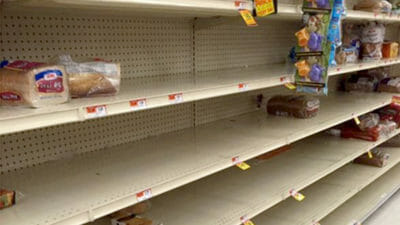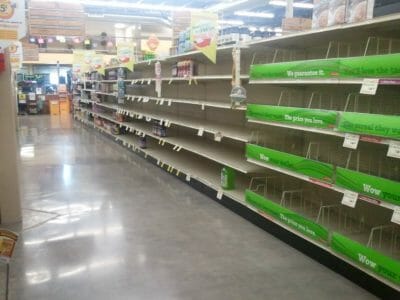I stopped at a supermarket recently to pick up a few items. I live out in the country and stay pretty well stocked up on food and supplies most of the time, but I keep a running list and make a habit of crossing items off it whenever I happen to be in town.
I walked into the produce section and encountered a shocking scene. Instead of the mounds of fresh fruits and vegetables piled high like I’m accustomed to seeing, I instead was met with the sight of bare wooden shelves.
An expanse of empty shelves in a big regional chain store is unnerving. We all realize that it does happen in extenuating circumstances, such as a blizzard or hurricane. And it is not unusual to find very few choices of hams available the day before Easter or the hot dog buns sold out on the Fourth of July weekend. But to find produce suddenly stripped bare on a random Spring day? Americans are not used to that.
I had seen temporary signs posted in the entrance, asking customers to excuse the appearance inside and citing the reason to be a recent warehouse fire further south, but had not paid them any real attention. In a first-world society where goods are easily acquired and food is abundant, we can afford to be dismissive of such notifications.
Just 30 Grams Of This Survival Superfood Provides More Nutrition Than An Entire Meal!
Or can we?
 A store worker advised me that it could be another few days before a shipment of fresh produce and other goods arrived. I often joke that where I live, in a rural area of a rural state, is “at the end of the food chain.” Food travels a long way to reach my grocery stores, often the width of the continent, sometimes leaving me with the choice of two-week-old peppers or rock-hard peaches. Even after crossing the state line, deliveries are made to stores in the handful of smaller cities further south before getting to my neck of the woods.
A store worker advised me that it could be another few days before a shipment of fresh produce and other goods arrived. I often joke that where I live, in a rural area of a rural state, is “at the end of the food chain.” Food travels a long way to reach my grocery stores, often the width of the continent, sometimes leaving me with the choice of two-week-old peppers or rock-hard peaches. Even after crossing the state line, deliveries are made to stores in the handful of smaller cities further south before getting to my neck of the woods.
It Was Right Here in America
Suddenly, it was no joking matter. The warehouse fire made me realize what it really means to be at the end of the line.
“Wow,” I exclaimed to my husband after leaving the store. “It felt like I had stepped into Argentina.”
It could have been any food-insecure place on the planet. But it was right here in America, in a place where people expect to have access to anything and everything, all the time.
There was nothing urgent on my list, and I knew there was a full pantry of canned and frozen goods at home. Being unable to purchase the food on my list that day was nothing more than an inconvenience for me.
But it was jarring to be faced with empty shelves, and it led me to ponder what-ifs. What if the fire had been at a major regional hub instead? What if it had been something with an even greater impact, such as a widespread power outage or a couple of major highway bridges washed out by floods or a damaging earthquake?
If I had been scared, I would have run through the produce section and scooped up everything I saw, from rutabaga to endive, whether it was on my list or not. But then again, if I had been scared, chances are other people would have been scared, too. If the situation had been serious, there might have already been a run on the store by the time I arrived, cleaning out not only the fresh foods but the cereal and canned corn and boxed stuffing mix and frozen pineapple and everything else, as well. What then?
 It is widely believed that grocery stores stock only three or four days’ worth of food at any given time. Modern transportation and computerized inventory management are generally considered reliable strategies for the 21st century.
It is widely believed that grocery stores stock only three or four days’ worth of food at any given time. Modern transportation and computerized inventory management are generally considered reliable strategies for the 21st century.
If the three-day inventory rule is accurate, it is likely calculated using sales during normal conditions. In case of an emergency, there is no way to know how long the store’s goods would last.
Are Most Americans Prepared?
Another what-if I considered is this: even during the minor interruption of food supply that did occur, what if my cabinets were bare and my refrigerator empty? It was just a few days, and there were still plenty of alternative food choices in the store. And there are other grocery chains—although most towns within an hour’s drive have only the one—so it still would not have been truly life and death. But for those large numbers of people who do not keep at least three days’ worth of food on hand, something as small as a regional warehouse fire could have a significant impact.
The Next Generation In Solar Backup Generators Is Finally Here!
This tiny little glitch in the food supply chain was a powerful wake-up call — even for me, a person already cognizant of possible shortages enough to consider myself something of a prepper. The experience of being surprised by empty shelves on an otherwise normal day made the concept of true disaster feel real somehow, and drove home how very fragile our food supply chain really is.
I wonder if most Americans are truly aware of how very close to the precipice we live our lives. A look around the world at empty store shelves and looting and long lines — waiting for basic food supplies — should prompt us to acknowledge that it really could happen to us. A severe weather event, a worker strike, a drought, a flood, an electronic mishap, a grid-down situation — any number of things could come between us and our ability to attain affordable food, with little or no warning.
Of the many reasons for stocking up and being prepared for the unexpected, people sometimes overlook the simplest and most likely to happen scenarios. But these events can be extremely valuable. They can remind us that emergencies can and do happen when we least expect them and help us remain aware of our own need to keep an adequate household food supply on hand.
Food insecurity on a wide scale may be less likely here in America than in many other corners of the globe, but it is folly to be so complacent as to assure ourselves that it can never happen here. My recent encounter with temporarily bare shelves is an excellent testament to the importance of being prepared for the unexpected, from the tiniest of inconveniences to absolute disaster.
Do you agree or disagree? Have you ever experienced empty shelves? Share your thoughts in the section below:
 Off The Grid News Better Ideas For Off The Grid Living
Off The Grid News Better Ideas For Off The Grid Living




